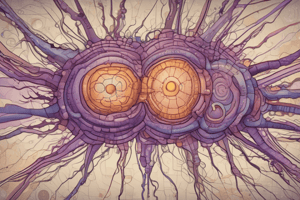Podcast
Questions and Answers
What is another name for childhood absence epilepsy?
What is another name for childhood absence epilepsy?
- Grand mal epilepsy
- Juvenile myoclonic epilepsy
- Seizure disorder
- Petit mal (correct)
Which of the following is not a type of epilepsy mentioned?
Which of the following is not a type of epilepsy mentioned?
- Temporal lobe epilepsy (correct)
- Grand mal epilepsy
- Juvenile myoclonic epilepsy
- Childhood absence epilepsy
What is the EEG reading associated with?
What is the EEG reading associated with?
- Juvenile myoclonic epilepsy
- Grand mal epilepsy
- Absence Seizure (correct)
- Childhood absence epilepsy
How many types of epilepsy are mentioned in the original content?
How many types of epilepsy are mentioned in the original content?
What is the name of the fourth type of epilepsy mentioned?
What is the name of the fourth type of epilepsy mentioned?
What is the consequence of neural exhaustion?
What is the consequence of neural exhaustion?
What is the final outcome of the process starting with continuous neural discharge?
What is the final outcome of the process starting with continuous neural discharge?
What type of causes usually lead to the process starting with continuous neural discharge?
What type of causes usually lead to the process starting with continuous neural discharge?
What occurs after cytotoxic edema in the process?
What occurs after cytotoxic edema in the process?
What is the first step in the process that leads to permanent neural damage?
What is the first step in the process that leads to permanent neural damage?
What is the timeframe for a normal attack?
What is the timeframe for a normal attack?
What complication can cause irreversible damage?
What complication can cause irreversible damage?
What is not a symptom of an impending status?
What is not a symptom of an impending status?
What is a symptom of an impending status that affects the heart?
What is a symptom of an impending status that affects the heart?
What is a complication that affects the lungs?
What is a complication that affects the lungs?
What is the primary consideration when selecting a treatment?
What is the primary consideration when selecting a treatment?
What is the first step in the treatment process?
What is the first step in the treatment process?
What is a key consideration when using medication?
What is a key consideration when using medication?
What is an important aspect of treatment duration?
What is an important aspect of treatment duration?
What is the relationship between the choice of drugs and the duration of treatment?
What is the relationship between the choice of drugs and the duration of treatment?
What are the potential causes of epilepsy?
What are the potential causes of epilepsy?
What is the initial step in managing a patient with epilepsy?
What is the initial step in managing a patient with epilepsy?
What is the purpose of intubation in the management of epilepsy?
What is the purpose of intubation in the management of epilepsy?
What is the significance of low flow O2 inhalation in epilepsy management?
What is the significance of low flow O2 inhalation in epilepsy management?
Why is it essential to monitor vital functions in patients with epilepsy?
Why is it essential to monitor vital functions in patients with epilepsy?
Study Notes
Types of Epilepsy
- Grand mal epilepsy (GME)
- Childhood absence epilepsy (petit mal)
- Juvenile myoclonic epilepsy
EEG Patterns
- Absence seizure patterns observed on EEG
Treatment of Epilepsy
- Choice of drugs depends on type of epilepsy and patient response
- Starting treatment: begin with low doses and gradually increase as needed
- Duration of treatment: varies depending on patient response and seizure control
- Stopping medication: gradual tapering to prevent withdrawal seizures
Complications and Risks
- Status epilepticus: prolonged seizure activity (>30 minutes) can lead to:
- Hyperpyrexia
- Hypotension
- Acidosis
- Hypoglycemia
- Cardiac dysrhythmia
- Shock
- Reflex pulmonary edema
- Aspiration pneumonia
- Neuronal damage (permanent and irreversible)
Causes of Epilepsy
- Organic causes:
- Metabolic disorders
- Infections (meningitis or encephalitis)
- Stroke
- Trauma
- Tumors
- Sudden withdrawal of anti-epileptic drugs (AED)
Management of Epilepsy
- On admission:
- Care of vital functions (BP, temp, respiration, heart rate)
- Intubation and low-flow O2 inhalation may be required
Studying That Suits You
Use AI to generate personalized quizzes and flashcards to suit your learning preferences.
Description
This quiz covers the different types of epilepsy, including grand mal epilepsy, childhood absence epilepsy, and juvenile myoclonic epilepsy. It also includes EEG readings and classification of seizures.





